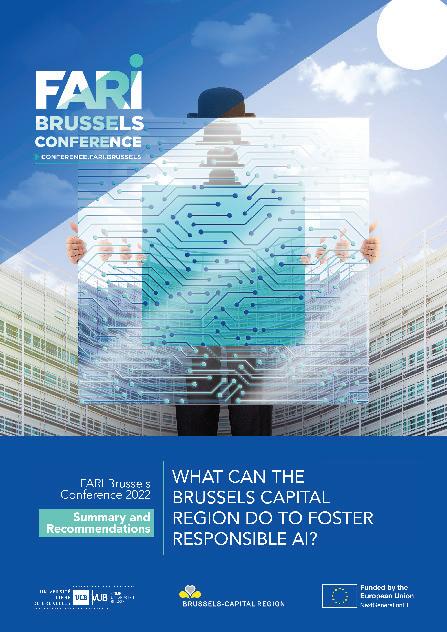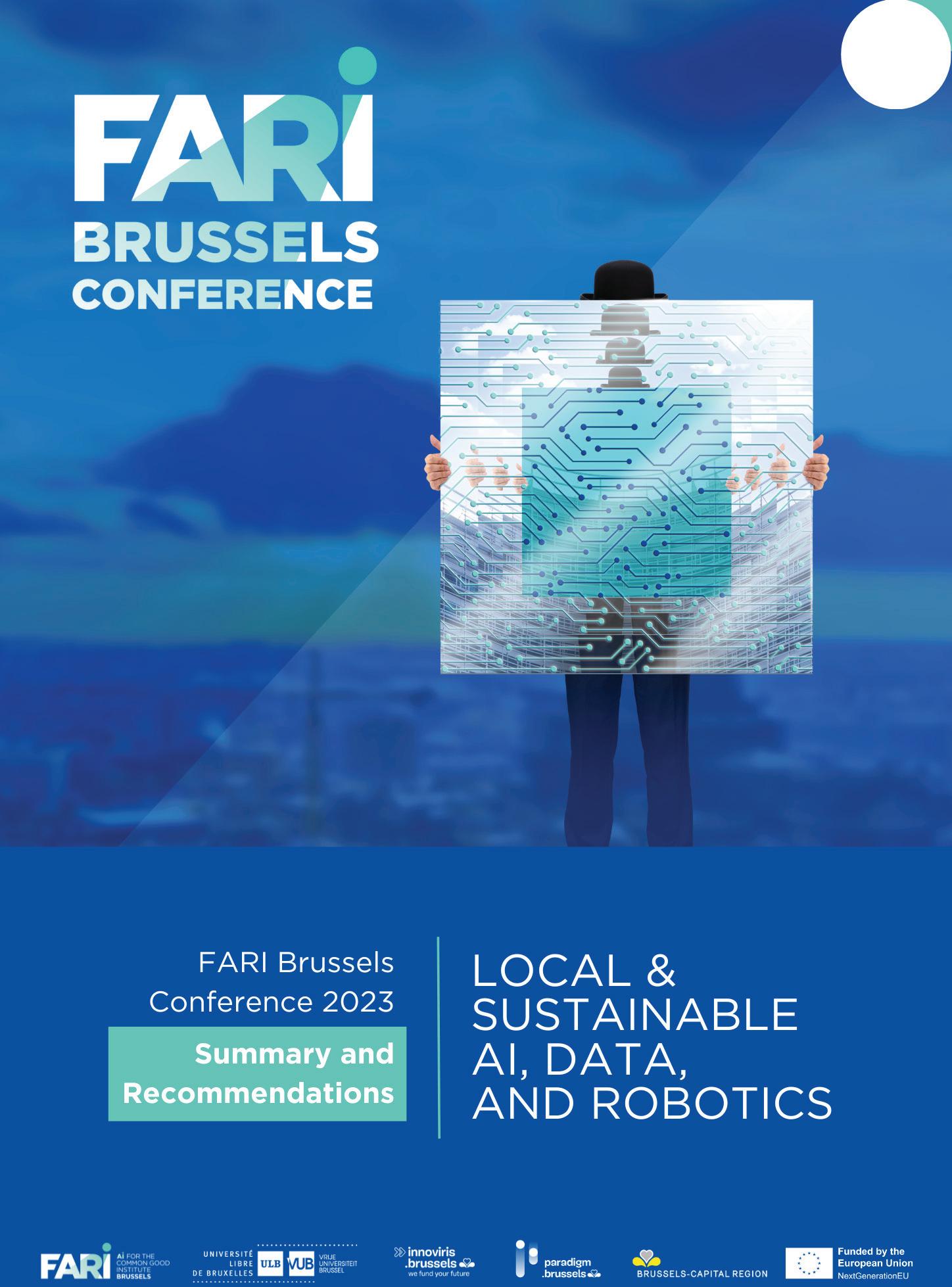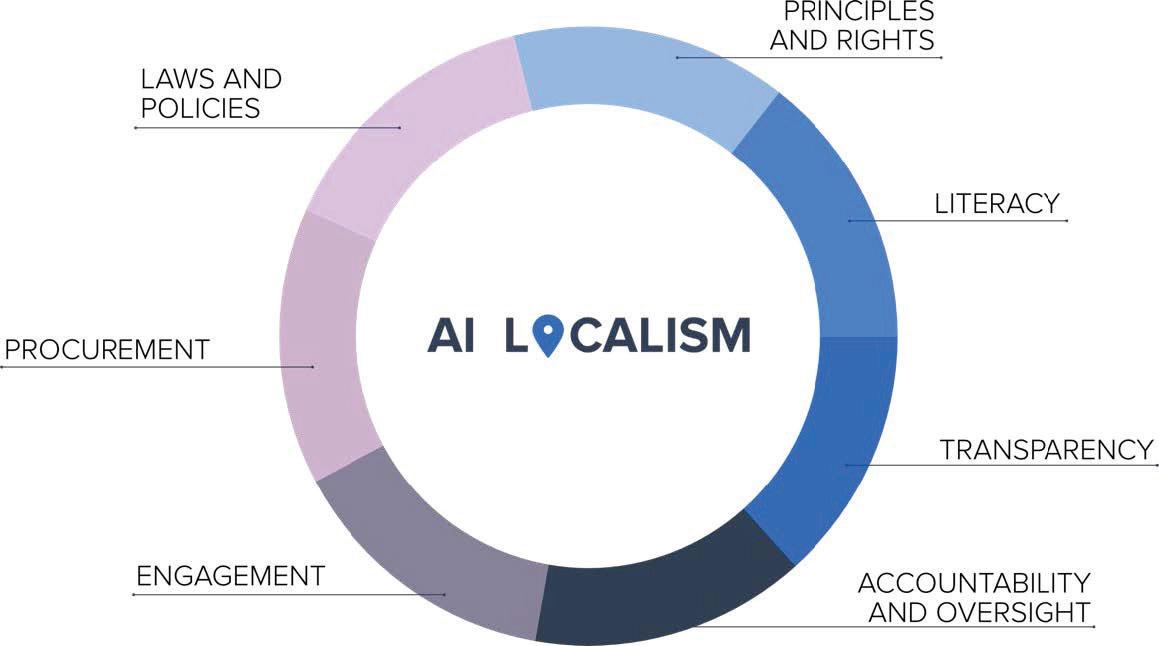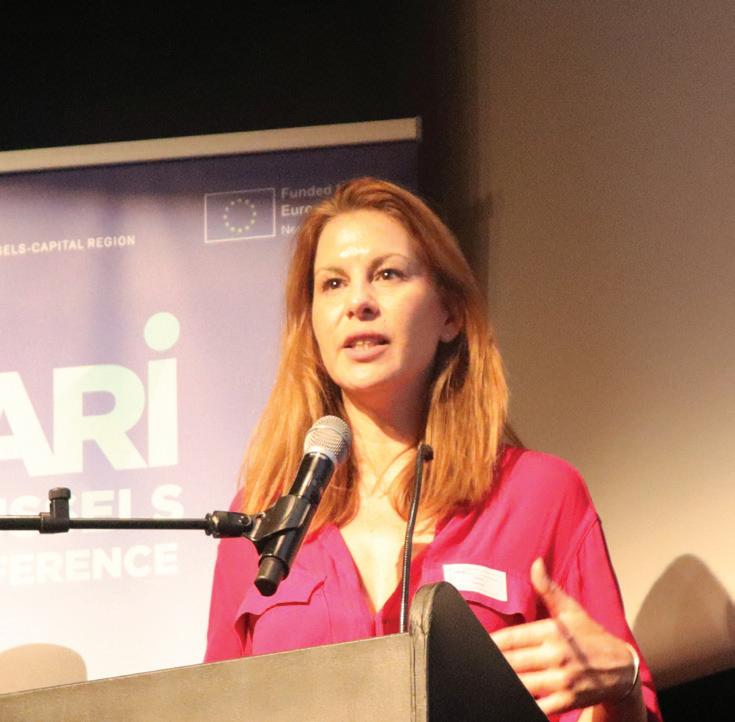


On September 11-12, 2023, the Brussels FARI - AI for the Common Good Institute (ULB-VUB) organised a conference on Local & Sustainable AI, Data, and Robotics. During this event, public officials, researchers, international city representatives and citizens were invited.
An Observer Committee attended all sessions to identify what the priorities could be for the Brussels Capital Region (BCR). It included local public servants and researchers.
This document summarizes the results and recommendations of the group of observers.
Local & Sustainable AI, Data, and Robotics
Authors: Hinda Haned, University of Amsterdam, Owls & Arrows
Anastasia Karagianni, VUB Cédric Verstraete, Innoviris
Editor: Carl Mörch, FARI
Part I: Summary of the International FARI Conference 2023
Part II: Recommendations for a functional and inclusive AI policy in the Brussels Capital Region
3 | Summary & Recommendation
Part I: Summary of the International FARI Conference 2023
In September 2023, FARI – AI Institute for the Common Good (ULB-VUB), convened its second international conference, bringing together policymakers, researchers, and the general public to delve into the transformative potential of AI, Data, and Robotics in fostering sustainable and inclusive urban development. Under the unifying theme ‘Progress without wisdom is not real progress”, the conference explored the ethical considerations that arise when employing AI for societal betterment, ensuring that the digital transformation benefits all without leaving anyone behind. This document summarizes the key findings and recommendations derived from the observers’ group.
#1 Local and Sustainable AI, when technologies meet communities
This year's conference kicked off with a session on how AI technologies can best serve communities: “Local and Sustainable AI, when technologies meet communities”. For AI technologies to effectively address the needs of communities and bring about positive change, they must be designed to solve real and pressing problems that are identified and prioritized by citizens themselves. The most effective way to achieve this is to involve citizens who are directly impacted by the decisions or processes that are made or generated using these AI systems. AI localism (See figure) is a term that has been coined to refer to local initiatives aimed at involving citizens in the ideation, design, and deployment process of AI systems. During the first panel discussion, we learned about some of the advantages of AI localism in shaping AI technologies to address
AI localism can help build trust and acceptance of AI technologies.


real problems. For instance, by involving local communities in the AI development process, AI localism can help ensure that AI technologies are developed to address real and pressing problems that are faced by these communities. This can lead to AI solutions that are more relevant, effective, and impactful. We also learned how, by involving citizens in the decision-making process around AI, AI localism can help build
2 | Summary & Recommendation

trust and acceptance of AI technologies. This is important because trust is essential for the successful adoption and use of AI.
However, balancing the legitimacy and effectiveness of local AI governance can be challenging. On one hand, citizen involvement and transparency are vital for legitimacy, requiring inclusive decision-making and accountability. On the other hand, effectiveness demands expertise, resources, and policies tailored to community needs, with the capacity to monitor and adjust. Striking a balance is challenging, as a focus on legitimacy may hinder efficiency, while prioritizing efficiency could compromise representation and transparency.
The panel discussed potential solutions to this challenge, such as adopting an agile approach to work, clearly defining expectations for citizen engagement, and “looking beyond optimization as a guiding value”, as one panel member put it. These approaches can help pave the way for normalizing and democratizing citizen engagement. Another important aspect raised during the discussion was the need for careful project scoping. In one example from Montreal involving the use of AI for traffic light optimization, 30% of the project timeline was dedicated to this stage. This highlights the importance of meticulously defining the scope and refining objectives before embarking on the AI development cycle.
While the panel members did not extensively discuss the challenges of bringing AI solutions to cities, delving into these challenges would be a valuable topic for next year's conference. Understanding the typical challenges encountered when designing and deploying these systems is crucial for developing effective and impactful AI solutions.

3 | Summary & Recommendation
Diagram illustrating the different components of AI localism. (Stefaan Verhulst)

#2 Methodologies to involve citizens around AI, Data, Robotics
AI, Data and Robotics are designed, developed and rolled out on a worldwide scale. Several insightful initiatives were shared during the panel discussion, demonstrating how involving societal actors fosters adoption, responsible design, and increased awareness. A few examples showcased how this works in practice:
• CollectiveUP: Empowers youth participation through training and creative workshops.
• Citizen Consultations: Robotics4EU: A consortium that gathers stakeholders from both the public and private sectors across six European countries to consult citizens on robotics adoption in key areas (e.g., healthcare, agile production). This process enables citizens to raise concerns or validate decisions, strengthening democratic principles within society.
• GlobalSay Platform: Facilitates selforganized engagement platforms.

4 | Summary & Recommendation
The panel discussion highlighted the critical role of societal actors in shaping the development and adoption of new technologies. This collaborative approach fosters responsible design, heightened awareness, and the incorporation of diverse perspectives, ensuring that technological advancements align with societal needs and values. Examples like GlobalSay underscore the value of online self-organized engagement platforms in facilitating this process. These platforms empower citizens to actively participate in shaping the future of technology, fostering a sense of ownership and ensuring that technological advancements reflect the collective aspirations of society.
The panel also acknowledged the resource limitations that can hinder citizen engagement in AI development and adoption, particularly in areas with limited access to technology. To address these challenges, they emphasized the need for offline training and educational resources that can be accessed by all, regardless of their digital literacy levels or access to computers and the internet. By bridging the digital divide and ensuring that everyone has the opportunity to participate, we can foster a more inclusive and equitable approach to AI development and ensure that the benefits of this technology are shared by all members of society.


Social robotics, another critical topic related to technology deployment and acceptance, was discussed. Examples of deployment in elderly care highlighted how these robots can offer potential benefits through cognitive games and brain fitness classes. However, involving end-users and domain experts is essential to avoid deployment issues
The role of AI in processing data from citizen engagement activities, like ideation exercises, was emphasized, and its potential to facilitate participation was recognized. Datawalks, which have been successful in the Brussels region, were proposed as a means to educate citizens about AI in the city. However, concerns about manipulating AI systems as literacy levels increase should be considered.
By bridging the digital divide, we can foster a more inclusive and equitable approach.
5 | Summary & Recommendation
#3 AI, Data, Robotics and Mobility
The rapid digitalization of mobility presents a multifaceted challenge, with a significant portion of the population lacking the necessary digital skills to fully participate in this transformation. According to recent statistics, 42% of EU citizens lack basic digital skills, and 32% have never used the Internet. This digital divide poses a significant barrier to the adoption and utilization of digitized mobility solutions, leaving a substantial segment of the population at risk of being excluded from the benefits and opportunities of this technological revolution.

Mobility should be considered a human right, emphasizing universal basic mobility and its role in promoting gender equality.


While AI holds potential to bridge the digital divide in mobility, practical implementation remains elusive. Some argue that mobility should be considered a human right, emphasizing universal basic mobility and its role in promoting gender equality. However, deploying AI in the public sector in general and mobility in particular, demands a robust data strategy, collaboration across sectors, and an innovation-focused mindset.
Another issue the panel focused on is the discrepancy between the envisioned potential of leveraging AI and data for Mobility-as-a-Service (MaaS) and the practical challenges, in particular, data is not collected equality from everyone, indeed some groups of people generate more data than others, which raises the question: how can MaaS tools cater to all citizens in equal and fair ways? Although the panel did not come up with a concrete answer to this very challenging question, the idea of developing and testing suitable governance and business models for MaaS platforms was discussed as an important area of focus for the future.
6 | Summary & Recommendation

The panel also discussed how vulnerable populations are often overlooked in the design of AI-driven mobility systems, exacerbating inequality. So what would it take to have digital mobility solutions serve everyone including vulnerable groups? The following recommendations were offered by the panel members:
• Provide friendly interfaces and assistance
• Provide human contact points
• Offer proper coupling of digital experience and physical experience
A key concern that emerged during the discussion is the potential over-reliance on AI, necessitating a careful balance between AI and human expertise to safeguard essential skills and knowledge. Additionally, there is a pressing need to address the needs of people with disabilities in discussions surrounding AI-driven mobility and establish clear guidelines for achieving sustainable development goals across environmental, economic, and societal dimensions, including accessibility to transportation, gender equality, affordable and clean energy, and cybersecurity.
Addressing the needs of people with disabilities in discussions surrounding AI-driven mobility is a pressing need.
7 | Summary & Recommendation
#4 AI, Data and Robotics in Public Services towards a new “algocracy”
Public authorities should set a high standard by prioritizing transparent and accountable AI development and deployment. The VADB's (Flemish Public Employment Service) ethics committee serves as an inspiring model, demonstrating how incorporating ethical considerations into the AI development process can yield positive outcomes.
The institution's guiding principles for responsible AI implementation offer valuable insights for organizations seeking to adopt ethical AI practices:
• Way of working: Embrace an iterative approach to AI development, characterized by experimentation, exploration, exploitation, and execution. This methodology encourages continuous learning, adaptation, and refinement to ensure AI solutions align with ethical principles and societal needs.
• Minimum Viable Product (MVP) by design: Prioritize the development of MVPs, ensuring that AI solutions are functional and tailored to user needs from the outset. This approach minimizes resource expenditure and allows for early feedback incorporation, leading to more effective and usercentric AI solutions.

8 | Summary & Recommendation
• Agile methodology: Adopt an agile development methodology that promotes flexibility, collaboration, and rapid adaptation. This approach enables organizations to respond dynamically to changing requirements and ensures that AI solutions remain relevant and aligned with ethical considerations.
• Diverse and cross-functional teams: Assemble project teams that encompass a diverse range of expertise and perspectives. This approach fosters a culture of open communication, encourages the exchange of ideas, and contributes to the development of more inclusive and ethical AI solutions.
The panel also highlighted why International collaboration is crucial for sharing expertise, exchanging best practices, and addressing societal challenges through AI solutions.


Embrace an iterative approach to AI development, encouraging continuous learning and refinement.
While regulations like the GDPR advocate for the "right to an explanation”, the practical implementation of this principle during the AI development cycle remains a challenge. In this context, providing practical guidance and support to organizations is often more effective than strict enforcement.
The Norwegian Digitalisation Agency's approach of providing tailored development and usage advice for specific AI applications offers a promising alternative to outright bans. This approach recognizes the complexity of AI development and the need for contextspecific guidance to ensure that AI solutions are implemented responsibly and ethically.
The panel also discussed how AI can enhance traditional literacy skills, aiding reading and writing through features like translation and speech-to-text. Defining sufficient transparency in AI systems is an ongoing dialogue for regulators, rather than a fixed legal standard, and careful consideration is required when contemplating the suppression of AI systems, ensuring control and enforceability. Additionally, digital literacy varies, encompassing both practical skills and the ability to access and interact with digital content, with ethical concerns regarding access, connectivity, and data sources.
9 | Summary & Recommendation

#5 AI and Justice
Access to justice is facing a significant crisis, characterized by delays, affordability issues, and a lack of transparency. Over 5 billion people worldwide lack meaningful access to justice, and in North America, 90% of the population cannot afford legal assistance. Lawsuits are also taking longer to resolve, with the average time in France increasing from 200 to over 600 days between 2016 and 2020.

AI solutions may be able to democratize access to justice, however, technology is advancing faster than legal frameworks, creating a gap between innovation and effective governance. Recognizing this challenge, the UN established Sustainable Development Goal 16, aiming to ensure access to justice for all and to build effective, accountable, and inclusive institutions at all levels.
Individuals should not sacrifice privacy for faster justice.
While AI and the Council of Europe's Convention on AI offer potential solutions to address these challenges, four key human rights concerns persist:
1. Algorithmic Bias: The question of whether fairness can be automated remains a pressing concern, as evidenced by the Dutch child care allowance fraud detection scandals. AI systems can perpetuate biases present in the data they are trained on, leading to discriminatory outcomes.
2. Exacerbating Inequality: AI's potential to exacerbate inequality, particularly among vulnerable populations, highlights the need for better access to solutions. AI systems can reinforce existing biases and create new barriers to access for those already marginalized.
10 | Summary & Recommendation
3. Privacy Concerns: The rise of digital surveillance raises concerns about the balance between efficiency and privacy. Individuals should not be forced to sacrifice their privacy in exchange for faster or more accessible justice.
4. Lack of Transparency: The lack of transparency in AI systems poses a significant threat to the rule of law. Without clear understanding of how AI decisions are made, it is difficult to hold these systems accountable and ensure that they uphold fairness and impartiality.
The panel agreed that bridging the digital divide and ensuring efficient justice processes while maintaining human judgment are essential principles in addressing these challenges. They recommended that judges should not be replaced by AI; as they play a crucial role in interpreting the law, applying sound judgment, and safeguarding human rights.
The panel agreed that while AI can bring justice closer to citizens, it is also crucial to consider the following:
• Human-Centered Justice: Justice must remain human-centric, with lawyers playing a crucial role in the courtroom. AI should complement, not replace, legal expertise.
• Legal Practitioner Involvement: Legal practitioners should be actively involved in the development and implementation of AI applications to ensure that these tools align with legal principles and ethical considerations.
• Access to AI Tools: Legal practitioners and their clients should have access to AI tools to enhance their ability to navigate complex legal systems and advocate effectively.
• Generative AI Limitations: Generative AI systems, while promising, have limitations in understanding the nuances of legal language and terminology. Legal professionals should not rely solely on generative AI for legal analysis or advice.
In conclusion, the panel agreed that harnessing AI for access to justice requires a balanced approach that prioritizes human oversight, transparency, and ethical considerations. By addressing the human rights concerns and ensuring responsible AI development and implementation, we can ensure that AI contributes to a more just and equitable society.

11 | Summary & Recommendation
#6 Sustainability, AI and Procurement
The panel discussion on AI procurement underscored the importance of maintaining a critical understanding of AI systems, avoiding anthropomorphization and recognizing their inherent challenges and limitations. Instead of advocating for a slowdown, the panelists emphasized the need to accelerate research and experimentation with AI systems, particularly in the public sector, to break free from the dominance of Big Tech companies.
When procuring AI for public services, it is crucial to consider the potential for AI to adapt to users' behavior and the possibility of user manipulation, which could lead to unintended harmful outcomes. Therefore, transparency is paramount. The Chilean initiative of mapping public algorithms, presented by one of the panelists, stands out as a commendable example of fostering transparency and accountability in AI development and deployment.
Innovation procurement plays a pivotal role in acquiring AI systems that often straddle the line between R&D projects and commercial ventures. Establishing sandboxes for testing AI and automated decision-making systems emerged as a promising approach to procure AI responsibly.
Key takeaways from the discussion on responsible AI sandboxing include:
1. Early Experimentation: Sandboxes should facilitate early-stage experimentation and testing of technologies, business models, and public innovation strategies before fullscale implementation.
2. Agile Adaptability: Sandboxes should embrace agility to adapt swiftly to the ever-evolving AI landscape.
3. Anticipatory Impact Assessment: Sandboxes should provide a controlled environment to anticipate the potential impact of AI systems.
4. Collaborative Stakeholder Involvement: Sandboxes should foster cocreation and feedback loops among stakeholders to ensure responsible AI development and deployment.


12 | Summary & Recommendation

In the current era of AI hype, it's easy to get swept up in grand visions of futuristic solutions. However, we must not overlook the value of simplicity and pragmatism. The corona app, initially hailed as a high-tech solution, ultimately proved to be a cautionary tale, highlighting the potential pitfalls of over-reliance on complex technologies without proper consideration of their real-world implications.
#7 Legal Protection Debt in the ML Pipeline
The panel discussion delved into the complexities of accountability in the lifecycle of datasets within AI modeling pipelines. A key concern raised was the potential for developers to evade responsibility for downstream tasks, leading to a legal protection debt.
Acknowledging the difficulty of predicting legal protection challenges in practice, the panel also recognized that data transformation into models poses an additional hidden risk that is not adequately addressed by current legislation. As one panel member put it: Datasets as the backbone infrastructure underpinning the development of machine learning. It follows that any data transformation process can introduce biases and inaccuracies into the models, further complicating the accountability landscape.
A critical gap identified was the limited capacity of organizations, both private and public, to monitor the impact of deployed AI models. This lack of oversight stems from a combination of factors, including a shortage of resources and a general lack of interest in addressing potential risks.
Datasets are the backbone infrastructure underpinning the development of machine learning
13 | Summary & Recommendation

Emphasizing the imperative of protecting fundamental rights, the panel highlighted the need for a comprehensive approach to data protection that safeguards human dignity.
The panel also expressed concerns about the absence of clear developer accountability in existing laws, particularly regarding the oversight of power dynamics in data sourcing decisions and academic incentives. Additionally, the exemption of developers from certain responsibilities under the GDPR raises concerns about the potential for national exemptions to arise, which could erode data protection standards.
Emphasizing the imperative of protecting fundamental rights, the panel highlighted the need for a comprehensive approach to data protection that safeguards human dignity. This approach should include a deeper understanding of the intricate relationship between human rights protection and data protection, with a particular focus on how this relationship is formulated and upheld.
In conclusion, the panel discussion underscored the need for a more nuanced understanding and proactive approach to addressing accountability challenges in the lifecycle of AI datasets. By fostering a culture of responsibility, enhancing organizational capacity for monitoring, and strengthening data protection safeguards, we can ensure that AI development and deployment align with ethical principles and societal values.
14 | Summary & Recommendation
#8 Sustainable Robots and Cities
The ongoing discourse surrounding robotics has shifted from a productivityversus-job-loss debate to a more nuanced focus on sustainability. Panel members showcased a range of robots, including hybrid beings and automated deconstruction robots deployed in construction sites, that are now interacting with humans in transformative ways, fostering material reuse and worker safety. These robots contribute to sustainability goals by removing mobility and accessibility barriers, freeing up time for more meaningful tasks, and assisting in combating environmental disasters and mitigating climate change.


However, implementing robots can be challenging due to the need for seamless integration into their deployment environments, often leading to operational complexities. There may be discrepancies between business goals and the practical needs of end-users. One example given during this panel to illustrate this, was the difficulty of integrating and maintaining robots into hospitals, which is time-consuming for healthcare providers who already face resource constraints.
Striking a balance between social, environmental, and economic domains is crucial, and this requires ongoing impact evaluations. Additionally, the risks associated with robots vary depending on factors such as their level of autonomy and the specific tasks they perform. This leads to context-dependent discussions about risk and mitigation strategies, such as those relevant to construction robots versus micro “injectable” robots.
The panel unanimously agreed on the importance of assessing technology's social and ecological impact and the need for balance in AI development, considering both increased productivity and job displacement concerns. Diverse teams and ethical considerations are also essential in this evolving landscape.
15 | Summary & Recommendation
Part II: Recommendations for a functional and inclusive AI policy in the Brussels Capital Region
Introduction
Throughout the FARI conference, we witnessed numerous examples of how diverse actors within the Brussels Capital Region are spearheading critical initiatives to develop genuinely inclusive and functional AI-driven systems. These efforts span the spectrum from public institutions and schools to private enterprises and civil society organizations.
Despite these commendable efforts, there remains an urgent need to ensure that AI technologies are not biased and can effectively promote inclusivity in societies where basic data literacy and internet access are still significant challenges for many citizens. Recognizing this pressing need, the observers committee has formulated a set of four key recommendations to foster the development and implementation of inclusive AI systems in the Brussels Capital Region.
It remains an urgent need to ensure that AI technologies are not biased and can effectively promote inclusivity in societies where basic data literacy and internet access are still significant challenges for many citizens.

16 | Summary & Recommendation
The Recommendations

Foster citizen engagement for an inclusive and beneficial AI ecosystem
To ensure that AI systems align with community needs and do not cause harm, it is crucial to cultivate a culture of citizen engagement in their development and deployment. This can be achieved by promoting AI localism initiatives, empowering citizens to participate directly in the design, implementation, and evaluation of AI systems. Additionally, leveraging the Brussels region's pioneering efforts in citizen education and involvement can set a benchmark for inclusive AI governance across Europe. By actively engaging citizens throughout the AI lifecycle, we can ensure that these technologies are developed and deployed in a responsible and ethical manner, maximizing their benefits for society while minimizing potential risks.
Establish a unified framework for developing truly inclusive AI technologies
To ensure the development and deployment of AI technologies that are accessible, ethical, and beneficial to all members of society, it is crucial to foster citizen engagement throughout the AI lifecycle and establish a unified framework for inclusive AI development. The unified framework should draw inspiration from successful public sector initiatives and combine Brussels' strong commitment to data and digital literacy. By adopting these recommendations, Brussels can position itself as a leader in inclusive AI development, paving the way for a more equitable and beneficial digital future for all.

17 | Summary & Recommendation




Implement Robust Safeguards and Guidelines for the Responsible Use of AI Technologies in Critical Applications
To ensure that AI systems align with community needs and do not cause harm, it is crucial to cultivate a culture of citizen engagement in their development and deployment. This can be achieved by promoting AI localism initiatives, empowering citizens to participate directly in the design, implementation, and evaluation of AI systems. Additionally, leveraging the Brussels region's pioneering efforts in citizen education and involvement can set a benchmark for inclusive AI governance across Europe. By actively engaging citizens throughout the AI lifecycle, we can ensure that these technologies are developed and deployed in a responsible and ethical manner, maximizing their benefits for society while minimizing potential risks.
Maintain criticality and transparency in AI development and deployment
AI development and deployment should be approached with caution and critical thinking, acknowledging that AI is not a cure-all solution and may not always be the most suitable approach to solving societal as well as business challenges. To maintain transparency in the use of AI-driven and automated technologies, algorithm repositories and other transparency mechanisms should be utilized. A balance between innovation and prudence should be struck, ensuring that AI is developed and deployed responsibly, safeguarding human rights and promoting societal well-being.

18 | Summary & Recommendation




Conclusion
This year’s FARI conference has provided a valuable platform for discussing the critical role of AI in shaping the future of the Brussels Capital Region. The insights and recommendations shared throughout the conference underscore the need for a comprehensive and inclusive approach to AI development and implementation. By prioritizing data literacy, embracing diversity, addressing algorithmic bias, and fostering user-centric design, the Brussels Capital Region can harness the potential of AI to create a more equitable, sustainable, and prosperous society for all.



FARI expresses its sincere gratitude to its supporters: the European Commission, the Brussels Capital Region, Innoviris, Paradigm and AI4Belgium.
19 | Summary & Recommendation












































